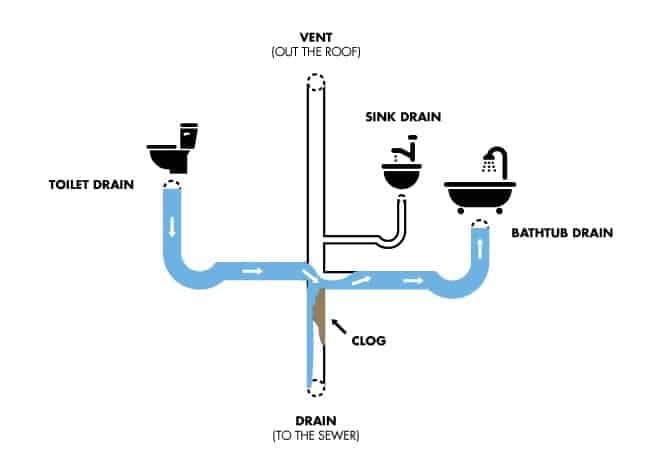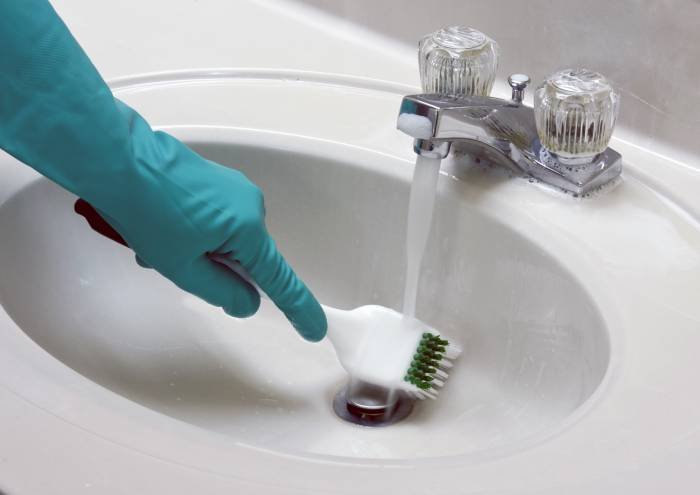Pop-Up Drains Versus Click-Clack Drains
Replacing your kitchen sink drain?
You have two great options for choosing a new sink drain – a pop-up drain or a click-clack drain. Each of these drains has pros and cons, so deciding which is right for you can be challenging.
This article will review the benefits and drawbacks of these two drains. You can make an educated decision about which type of sink drain is ideal for your property.
So, without further ado, let’s take a closer look at pop-up drains and click-clack drains…
From VictoriaPlum.com
What are pop-up drains and click-clack drains?
What is a pop-up drain?
A pop-up drain is a sink drain that uses a lever to open and close the drain stopper. The lever is usually located on the side of the sink, near the faucet.
You push down the lever when you want to close the drain stopper. This will cause the stopper to close and the water to drain from the sink.

To open the drain stopper, you pull up the lever. This will allow water to flow into the sink.
Pop-up drains are popular because they are easy to use and don’t require special tools or knowledge to operate.
What is a click-clack drain?
The drainage plug’s “click-clack” waste is simply the drain stopper, which is operated by pushing it down (sometimes simultaneously turning it) to open and close it. When the drainage plug rises, a “clack” may be heard, and when pushed back down, there is a “click.”

As a result, it is also commonly known as a “lift and turn” or “tip-toe” drain. Click-clack drains are common in many bathrooms, including bathtubs, showers, and sinks.
The pros and cons of pop-up drains
One of the most important benefits of a pop-up drain is that it is effortless to install. In most cases, it can be done without hiring a professional. As a result, it’s a fantastic choice for individuals trying to save money on their bathroom renovation. Additionally, pop-up drains are relatively inexpensive compared to other drains.
There are a few disadvantages to consider as well. One is that pop-up drains can be difficult to clean. Since they are under the sink, they can be hard to reach and require special cleaners. Additionally, if not installed correctly, pop-up drains can leak. This can cause water damage to your bathroom and potentially create mold and mildew problems. If you are considering a pop-up drain, consult a professional to ensure it is installed correctly.
Overall, pop-up drains have both advantages and disadvantages. They may be a good option if you are trying to save money on your bathroom renovation. However, if you are concerned about leaks or want an easier-to-clean drain, you may want to consider a different type of Drain.

The pros and cons of click-clack drains
Compared with Pop-up drains, Click-Clack drains have many advantages; for example,
Click-Clack drains are easier to install and remove; they provide a watertight seal so that no water can escape and cause leaks, and they are less likely to become clogged because hair and debris can be easily flushed away.
However, Click-Clack drains also have some disadvantages.
For one, they can be pretty noisy—the constant clicking sound can be pretty annoying, especially in a quiet room. Secondly, because Click-Clack drains rely on a seal to keep water from escaping, they are not recommended for use with very hot water, as the heat can damage the seal.
So, there you have it—the pros and cons of Click-Clack drains. Considering installing one in your home, weigh the advantages and disadvantages to see if it is the right choice.

Which type of sink drain is right for you?
Choosing the right sink drain matters for your kitchen or bathroom. Will you agree with this?
You need to look into some things before purchasing a sink drain. Here we will give some tips for your reference.
Material
The first is the material. The most common materials used for sink drains are stainless steel, brass, and bronze. Each of these materials has its own advantages and disadvantages.
- For example, stainless steel is durable but can be challenging to clean.
- Brass is easy to clean but can tarnish over time.
- Bronze is durable and easy to clean but is also the most expensive option.
Size
The next to consider is the size of the Drain. Sink drains come in various sizes, so you must choose one that fits your sink.
The regular size is about two inches in diameter, but you can also find three or four inches in diameter drains. Measure your sink before purchasing a drain to get the right size.
Shape
The next thing to think about is the shape of the Drain. The most common conditions are round and oval, but you can also find square or rectangular drains.
You will need to choose a shape that fits your sink.

Colour
You also need to think about the color of the Drain. The most common colors are chrome and brushed nickel, but you can also find black or white drains.
Choose a color that coordinates with your other bathroom fixtures.
Style of design
The third consideration is the sink drain’s style. Sink drains come in various kinds, including traditional, contemporary, and transitional. You can pick a style that matches your kitchen or bathroom décor.
Drain Installation
The sink drain can be either top-mounted or bottom-mounted.
Top-mounted drains are installed on the sink and have a visible lip extending over the sink’s edge.
Bottom-mounted drains are installed underneath the sink and are not visible from above.
Type
Last, we come to the type of Drain; as per our previous comparison for POP-up and click-clack drains, you can get some hints for your selection.
We think the above information is helpful for you in making a decision when purchasing a sink drain.
How to install a new sink drain
Pop-up Drain
Pop-up drain installation is pretty straightforward. You only need a few tools and materials, and you can do it yourself in just a few minutes. Here’s what you’ll need:
- A basin wrench
- A putty knife
- Teflon tape
- Plumber’s putty
Step #1 Start by shutting off the water to your sink. Then, use the basin wrench to loosen the pop-up assembly’s nut. Be careful not to damage the sink when you’re doing this.
Step #2 Once the nut is loose, remove the entire assembly from the sink. Clean off any old plumber’s putty or gunk on the sink surface. Then, wrap some Teflon tape around the threads of the Drain.
Step #3 Now, it’s time to apply the plumber’s putty. Roll a small amount into a snake-like shape and place it around the edge of the drain hole. Make sure you press it firmly into place, so there are no gaps.
Step #4 Finally, screw the pop-up assembly back into place. Be sure to hand-tighten it so that you don’t damage the threads. Once it’s tight, turn the water around and test your new sink drain!
From Rooter Hero Plumbing of Los Angeles
Click-clack Drain
Click-clack drain installation is more involved than a pop-up drain, but it’s still not too difficult. You’ll need the following same tools mentioned above.
Step #1 Remove the old Drain. Use the basin wrench to loosen the large nut that holds the Drain in place. If the nut is too tight, you may need a hammer to tap the wrench. Once the nut is loose, unscrew it by hand and lift out the old Drain. Save the washers and rubber gaskets, as you’ll need these for the new Drain.
Step #2 Clean out the drain opening. Use the putty knife to remove any old plumber’s putty or sealant. Then, wrap the threads of the Drain with Teflon tape. This will help create a watertight seal.
Step #3 Now it’s time to install the new Drain. Start by attaching the rubber gasket and washers to the Drain. Then, fit the Drain into the opening and hand-tighten the large nut. Finally, use the basin wrench to tighten the nut completely. Be careful not to overtighten, as this could damage the sink.
Step #4 Once you’ve installed the new Drain, you can apply the plumber’s putty around the base. This will create a watertight seal and help prevent leaks. Allow the putty to dry for 24 hours before using the sink. And that’s it! You’ve successfully installed a new sink drain.
How to troubleshoot common sink drain problems
For many people, the kitchen or bathroom sink is the most frequently used plumbing utility. While it is designed to withstand a lot of use and abuse, there may come a time when you need to troubleshoot some common sink drain problems.
A slow-draining sink.
Let’s look at the pop-up Drain: you must follow specific procedures to see whether anything is blocking the Drain.
- Remove the Pop-up: unscrew the knob at the top of the Drain. After that, unscrew the cap and washer to take out the entire assembly.
- Check the Trap: Use a flashlight to look into the P-trap for any foreign objects clogging it. If you see anything, remove it with pliers or your hands.
- Check the Trap Arm: The trap arm is the curved pipe that connects the P-trap to the drain line. Use a flashlight to look for any clogs or blockages. If you see any, use a plunger or snake to remove them.
- Snake the Drain involves feeding a long, flexible wire into the Drain to clear any blockages. If you don’t feel comfortable doing this yourself, you can always call a plumber.

Clogged Kitchen Sink
A clogged kitchen sink is one of the most common sink problems. You can do a few things to try to clear the clog yourself.
- Use a Plunger: The first thing you should try is using a plunger. Cover the other Drain in your sink with a wet rag to create suction. Then, plunge up and down vigorously for several minutes.
- Use Your Own Eco-Friendly Drain Cleaner: Several reasons to avoid utilizing chemical drain cleaners. They are bad for the environment and can also be dangerous to use. Mix equal parts baking soda and vinegar to try a more natural method. Pour it down the Drain and let it sit for an hour before flushing it with hot water.

Jammed Garbage Disposal
Garbage disposals can be a lifesaver when dealing with food waste. But it can be a real pain if your garbage disposal becomes jammed.
- Turn Off the Disposal: You first need to turn off the power to the disposal. You don’t want to risk getting injured by an accidental start.
- Use a Plunger: Like with a clogged sink, you can use a plunger to unjam your garbage disposal. Put the plunger over the Drain and plunge up and down several times before running hot water down the Drain.
- Use a Hex Wrench: If the disposer is jammed, you may be able to use a hex wrench to loosen it. Locate the hexagonal hole at the bottom of the disposer and insert the wrench. Turn it back and forth until the jam is reduced.
Wrapping up
So, which type of sink drain is right for you? If you’re still unsure after reading this article, don’t worry – contact us, and we’ll help you decide.
With over 17 years of experience in basin waste manufacturing, we know a thing or two about sink drains!
If you have any questions or comments, please leave them below. And be sure to check back often for more tips and tricks from your friends at hofensanitary.com.

